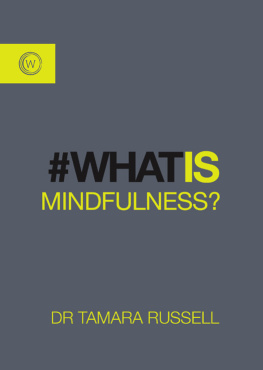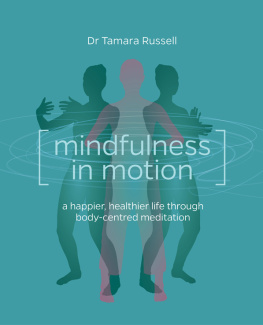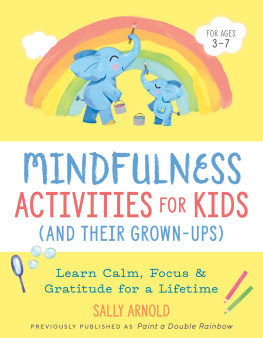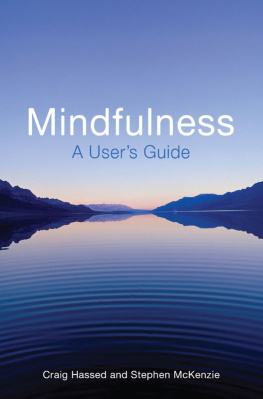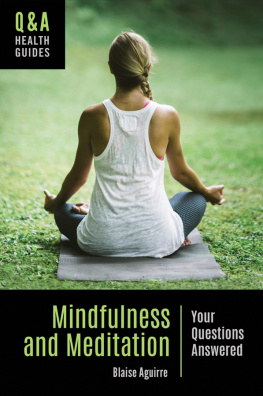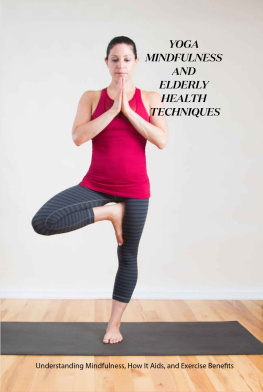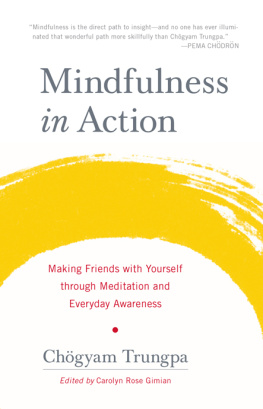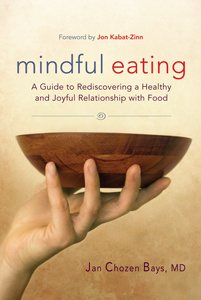#WHAT IS
#WHAT IS
MINDFULNESS?
DR TAMARA RUSSELL
CONTENTS
Why read this book?
My aim in writing this book is to provide you with a friendly, accessible guide to mindfulness such a popular term these days, yet one that is rarely fully understood. I would like to give you a broad understanding of the topic, as well as clear up some common confusions. With more insight into the meaning, mechanisms and origins of mindfulness, I believe its possible for everyone to find a way to weave mindfulness into their daily lives. Im passionate about the brain and keen to share the exciting neuroscientific research thats helping us understand why mindfulness really can work. As we all know, we need clear and calm thinking to meet the challenges our world is facing. Mindfulness is one route to ensuring we proceed with this consideration and clarity rather than knee-jerk reactions. In a more mindful world there is room for us all to thrive. I hope this book will inspire you to consider where in your world there is an opportunity to act with more care and attention, and in line with your deepest and most heartfelt intentions.
20 reasons to start reading!
Explore the meaning and concept of mindfulness
Differentiate between mindfulness and ordinary awareness
Recognize that you already have mindfulness within you
Discover how mindful living benefits both body and mind
Understand the key brain networks you are using and developing when you practise mindfulness
Become familiar with different types of attention and how we can fine-tune our attentional capabilities
Get better acquainted with your wandering mind, and harness its power in line with your intentions
Learn how to learn in the most efficient ways
Understand the benefits of engaging with lifes challenges in a less reactive, more considered way
Improve your self-knowledge and awareness of your own personal habits of mind
Feel confident you can make any activity mindful
Learn how developing awareness is in our genes
Hear the story of how many human civilizations have explored and developed awareness
Learn how modern-day mindfulness has grown into the globe-spanning phenomenon it is today
Learn how to prepare for mindfulness training, making your efforts most efficient
Discover how to be mindful in mindless environments
Reflect on your own personal learning style and how this will interact with attempts to unveil your innate mindfulness
Explore three key mindfulness practices in depth
Challenge yourself to embed mindfulness in everyday activities and interactions
Embrace the joy and pain of the human condition to continually learn and grow
From the list on the previous pages, you can see that Im keen for you to explore this topic from all angles, so you really know what you are getting into if you decide that mindfulness is for you. Being prepared will speed your journey and make it more fun. You may explore lightly or want to go deep. You are at your own starting point and I hope that this book will give you all you need to know to begin your explorations.
Key features of this book
In the Introduction that follows, I provide the context for this book and my work and my motivations for writing it. considers what happens with continued, dedicated practice and whether it might be possible to create more mindful communities, and, ultimately, a more mindful world.
This book has a number of features to make mindfulness as accessible as possible for you. These include:
A Q & A approach that, chapter by chapter, explores the questions that are often asked about mindfulness.
Focus On boxes that invite you to go deeper into a practice or topic and think about how it applies in your life.
Try It boxes that suggest practical exercises you can try right now to explore a learning/teaching point.
At the end of the book, a What Next section and further reading list suggest how to continue your investigations. This book is a first dip into the topic; if you really want to dive in, there are many more fascinating things to discover.
KEY ABBREVIATIONS
The following abbreviations are used in the book for key terms (the terms themselves will be explained on first mention):
MBSR Mindfulness-Based Stress Reduction
MBCT Mindfulness-Based Cognitive Therapy
DMN Default Mode Network
INTRODUCTION
Why this subject?
We are often overwhelmed in the media with articles and stories about mindfulness: how it can help with relationships, at work, in sports, with the management of emotions and the development of emotional intelligence. The list goes on! But how can it be that one thing can have an impact across so many areas of our life and society? How is it that mindfulness in the many and various formats that we find it can seem to have such a dramatic influence on peoples lives? And as well as those who point to mindfulness as a panacea for what ails modern society, there are also plenty of sceptics. It is a fascinating and important subject, but what is the reality?
I have seen mindfulness, which is, at its core, a mind-training tool, benefit a wide range of people from those who want to become more productive at work, to those who are seeking answers to larger, spiritual questions and those who just want more ease and gentleness in their life. However, there is huge variation in the way that it is and can be taught.
As this mental training technique has migrated from its beginnings in the monasteries to the mainstream, it has been adapted, reshaped and repositioned. While adaptations are to be encouraged, some of this reshaping has led to frustration and disappointment, as people are often left not really understanding how to do it or what to expect. At the heart of the ongoing debates we find a number of common misunderstandings about mindfulness. These misconceptions have proliferated as mindfulness has spread like wildfire through society.
Unrealistic expectations are one of the most common pitfalls. Some people believe they can achieve the full benefits of mindfulness if they spend just five minutes a day using an app on their morning commute. Although they are engaging in mindfulness training, its important to make clear that this level of practice will not achieve the same results as, say, practising a body scan exercise almost every day for 45 minutes over 8 weeks (as in a standardized mindfulness training programme). And neither of these is likely to come close to what is attained by a lifelong practice and commitment to specific practices, in a specific order (as in the Buddhist training path). Yet, they are all ways of practising mindfulness.
Trying to find clarity even around the definition of mindfulness in the secular domain has been problematic. Is it a state of mind, a training method or simply a way of being or doing? This book will define and discuss the key principles of mindfulness so you can gain a better understanding of it, explore how it can benefit your life and clarify what you want to achieve, how you plan to do it and what the likely rewards will be for your efforts.
Understanding the basics of the underlying theory and neuroscientific research behind mindfulness will help explain the how and why of certain practices, and help you think clearly about your intentions, expectations and associated effort and motivation if you take up mindfulness practice. As such, a simplified model for mindfulness will be presented that captures the key neuroscientific features of a focused attention process. Common confusions will be cleared up as we work our way through this, which will help you to refine your attempts at (or your existing) mindfulness practice and allow you to make more out of the time you are spending doing mindfulness.

